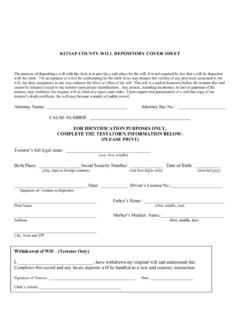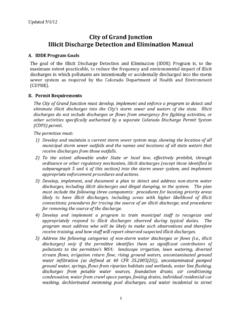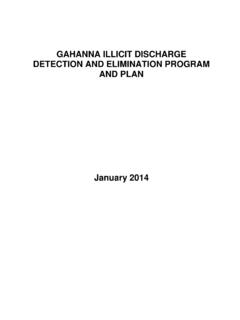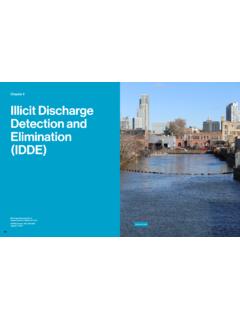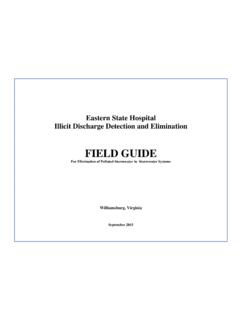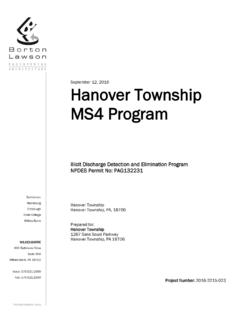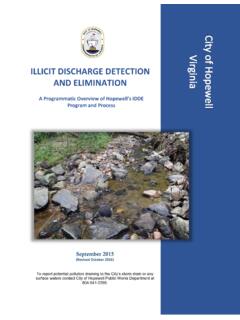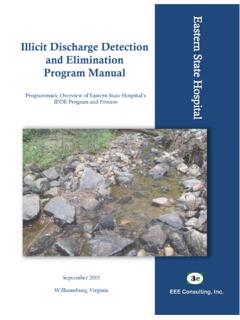Transcription of Illicit Discharge Detection and Elimination (IDDE) Program
1 Illicit Discharge Detection and Elimination (IDDE) ProgramKitsap County Public WorksJune 2011ii Illicit Discharge Detection and Elimination (IDDE) Program Kitsap County, Washington Illicit Discharge Detection and Elimination (IDDE) Program Table of Contents Overview ..1 Municipal Storm Sewer System Mapping ..2 Current Program ..2 Ordinances ..3 Current Ordinances ..3 Detection and Elimination Program ..3 Response to Suspected or Reported Illicit Discharges ..3 Proactive Investigation ..4 Prioritization Procedures ..4 General Field Assessment Procedures ..5 Physical Parameters ..6 Water Quality Sampling and Testing ..7 Immediate Response Procedures ..8 Isolating Illicit Discharges (Source Tracing) ..9 Investigation and Response Procedures.
2 10 Public Education .. 11 Public Information .. 11 Reporting and Recordkeeping .. 11 Tracking (Spills, Inspections, and Public Comment/Feedback) .. 11 Staff Training .. 12 Training Lead .. 12 Detailed Training .. 12 General Training .. 12 References .. 13 Appendices Appendix A: Permit Compliance Schedule Appendix B: Dry Weather Monitoring Sampling Manual Appendix C: Outfall Reconnaissance Inventory/Sample Collection Field Sheet Appendix D: Illicit Discharge Hotline Incident Tracking Sheet Appendix E: Public Education 1 Illicit Discharge Detection and Elimination (IDDE) Program Illicit Discharge Detection and Elimination (IDDE) Program Overview An Illicit Discharge is generally any Discharge , release, or pumping of a pollutant or polluted water into the stormwater system.
3 The National Pollutant Discharge Elimination System (NPDES) regulates the Discharge of stormwater under the authority of the Federal Clean Water Act. Washington State Department of Ecology (Ecology) has the designated authority to administer NPDES within the state of Washington. Under this authority, Ecology has issued NPDES permits regulating the Discharge of stormwater. Kitsap County is under the regulation of the Phase II Municipal Stormwater Permit issued on February 16, 2007. The current Phase II permit will remain in effect until February 15, 2012, after which a new Phase II permit will be issued. The Phase II permit mandates permittees to prepare and implement an Illicit Discharge Detection and Elimination (IDDE) Program . This plan and its implementation satisfies this requirement.
4 The goal of this plan is to identify and then eliminate Illicit discharges. Examples of Illicit discharges include: Direct or indirect sanitary wastewater discharges that connect to the storm sewer or watercourse, such as a shop floor drain connected to a storm drain, a cross-connection between the municipal sanitary sewer and storm sewer systems, a damaged sanitary sewer line that is leaking sewage into a cracked storm sewer line, or a failing septic system that is leaking into a water course. Materials ( , used motor oil) that have been dumped illegally into a storm drain catch basin. Improper home or business owner activities such as washing paint brushes into a catch basin, washing new textured concrete driveways into a storm drain, draining swimming pools to the storm system (swimming pools have high pH and chlorine), excess use of fertilizers, or washing cars with chemicals that enter the storm drain system.
5 The NPDES Permit sets forth the minimum elements of the plan which are listed below. These minimum elements are described throughout the remainder of this document. Municipal Storm Sewer System Mapping Ordinances (that effectively prohibit Illicit discharges) Detection and Elimination Program Public Education Staff Training Unincorporated Kitsap County has 156 miles of marine shoreline and numerous lowland streams. The storm system is exclusive of the Cities of Port Orchard, Bremerton, Poulsbo and Bainbridge Island, and military and tribal lands. No large rivers are found in 2 Illicit Discharge Detection and Elimination (IDDE) Program Kitsap County. Additionally, several small lakes are located in the county. Approximately 70 miles of shoreline are within the permit designated municipal separate storm sewer system (MS4) area.
6 However, about 93 miles of marine shoreline was evaluated. Kitsap County Public Works Surface and Stormwater Management s (SSWM s) policy is to treat all receiving waters, whether in the designated MS4 or outside the MS4, as valuable water resources and subject to stormwater management activities, which will help protect and improve these resources. The remaining 63 miles of shoreline not evaluated was determined to be sparsely populated with little or no stormwater infrastructure discharging to marine water. Unincorporated Kitsap County s storm system includes rural areas with ditches and road cross culverts; urban centers with pipes, catch basins and storm facilities (ponds/vaults/tanks/swales); and residential areas with a combination of ditches, pipes, catch basins and storm facilities.
7 Kitsap County SSWM implemented an extensive IDDE outfall screening Program from 2000-2008. The Program visited over 1,500 outfalls and 68% were connected to the County stormwater drainage system and the remaining 32% were private or natural drainage systems. Municipal Storm Sewer System Mapping Current Program The County currently has the following stormwater-related information in their geographic information system (GIS) database: Storm sewers Catch basins and manholes Ditches Streams (watercourses) Outfalls The current Program is compliant with the NPDES permit requirements and is completed in advance of the established February 2011 deadline within the permit. Some of the more specific elements of the Program as required by the permit are listed below: 1.
8 A map of all structural BMPs owned, operated, or maintained by the County. 2. For pipe outfalls 24-inch-diameter pipes and watercourse outfalls, a map with the following attributes for each outfall: tributary conveyances (type, material, and size where known), associated drainage areas, and land use. Although most of the watercourses and pipes have a cross-sectional area less than a 24-inch-diameter pipe, the County has elected to consider and map all of the known pipe outfalls 6 inches or greater and all flowing (dry weather) watercourses including seeps and drainages. 3. A Program to develop and maintain a map of all connections (ditch or pipe) to the County s storm system allowed or authorized after January 2007. 3 Illicit Discharge Detection and Elimination (IDDE) Program 4.
9 A map of areas of the County that do not Discharge stormwater to surface waters. This would be any enclosed depression, isolated wetlands, or large areas relying on infiltration. This data is preferred to be in electronic format with documented mapping standards. The County s mapping is already in electronic format and is available on the web at Ordinances Current Ordinances Kitsap County Code Chapter Water Quality prohibits Illicit discharges (section ) and Illicit connections and uses (section ). Connections to the stormwater system must contain only stormwater and groundwater otherwise they are to be eliminated. Detection and Elimination Program Response to Suspected or Reported Illicit Discharges The County currently has a Surface and Stormwater Management Program that is fully staffed to fulfill an Illicit Discharge Detection and Elimination (IDDE) Program which includes: commercial property inspections, outreach and education, water quality monitoring and stormwater system operation and maintenance.
10 Kitsap County maintains a hotline, Kitsap 1, that citizens can call during business hours to report a suspected Illicit Discharge . Kitsap 1 Phone Numbers: (360) 337-5777 or (800) 825-4940 Website with Kitsap 1 information and Email Address: Kitsap County (Public Works and Department of Community Development), Kitsap Conservation District (KCD) and the Kitsap County Health District (KCHD) respond to public reports of water quality problems. These reports provide a source of information which help SSWM respond quickly to spills, intentional dumping, leaks and on-going problems. SSWM funds complaint response for each partner agency. Agencies respond to complaints specific to their area of expertise (Appendix D): 4 Illicit Discharge Detection and Elimination (IDDE) Program o PW responds to water quality problems associated with the County road and stormwater system.







